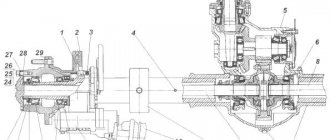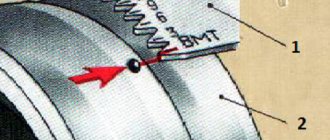The vehicle's carrying capacity is the difference between its gross weight (with contents and people) and its unladen weight. It is calculated by subtracting the second indicator from the first, both numbers are indicated in the PTS by the vehicle manufacturer. A passenger car can transport a maximum of 2.5 tons, a truck - over 8 tons, and a road train - up to 28 tons.
Sometimes the carrying capacity indicated in the PTS does not correspond to the real one; it can be more or less than this value. Then it’s worth making a change to the document by contacting the traffic police and identifying the real indicator with the help of an examination. Otherwise, the driver will receive a fine of 500 rubles for overloading.
In this article:
Vehicle Loading Capacity
Dictionary of business terms. Akademik.ru. 2001.
See what “Carrying Capacity of a Vehicle” is in other dictionaries:
The carrying capacity of a vehicle is the weight of the cargo that the vehicle is designed to transport. Source: Guidelines for conducting an independent technical examination of a vehicle under compulsory motor liability insurance (N 001MR/SE) (approved by NIIAT of the Ministry of Transport of the Russian Federation on October 12, 2004, ... ... Official terminology
vehicle length - 2.4.1 vehicle length: 2.4.1.1 for vehicles of categories M, N and O: Dimension determined in accordance with 6.1 ISO 612 [1]. In addition to the requirements [1], when determining the length of a vehicle, they should not be taken into account... ... Dictionary of terms of normative and technical documentation
vehicle length - 1. For vehicles of categories M, N and O Size determined in accordance with 6.1 ISO 612 [1]. In addition to the requirements [1], when determining the length of a vehicle, the following devices should not be taken into account: devices... ... Technical Translator's Reference
LOADING CAPACITY - a vehicle (car crane, etc.), the maximum weight of cargo that it is capable of lifting, moving or transporting in one go under certain conditions (see also Deadweight) ... Big Encyclopedic Dictionary
Loading capacity - The carrying capacity of a vehicle (wagon, car, ship, aircraft, forklift) is the mass of the cargo that the vehicle is designed to transport; the main operational characteristic of the vehicle. For land... Wikipedia
Bridge load capacity is a characteristic of a bridge determined by the maximum temporary vertical moving load of a certain type (for example, in the form of a car or a uniformly distributed load with a trolley), the impact of which is safe for its carriers ... Construction Dictionary
GOST R 52389-2005: Wheeled vehicles. Masses and sizes. Technical requirements and test methods - Terminology GOST R 52389 2005: Wheeled vehicles. Masses and sizes. Technical requirements and test methods original document: 2.1.2.1 bus: A vehicle of categories M2 and M3, designed and intended... ... Dictionary of terms of regulatory and technical documentation
length - 3.1 length l: The largest linear dimension of the front face of the sample being measured. Source: GOST R EN 822 2008: Thermal insulation products used in construction. Methods for measuring length and width ... Dictionary-reference book of terms of normative and technical documentation
load capacity - and; and. The maximum mass of cargo that can be lifted by a mechanism or transported by a vehicle in one step. Heavy-duty crane. Small ship. * * * lifting capacity of a vehicle (crane, car... ... Encyclopedic Dictionary
tonnage - (French tonnage) 1) register capacity of a ship; 2) carrying capacity, cargo capacity of vehicles, transport. New dictionary of foreign words. by EdwART, , 2009. tonnage, pl. no, m. [fr. tonnage]. 1. Weight or volume of the vessel in tons ... Dictionary of foreign words of the Russian language
What it is?
In short, this is a value showing how much cargo, including live cargo (passengers), can be safely transported by a car.
As noted, many do not pay attention to this parameter, but in vain. It is extremely important. Several arguments in support:
- If the car is overloaded, there is a risk that something will break in it along the way. For example, the suspension elements will not hold up and the tires will burst. In the worst case, this can lead to an accident with serious consequences. At best, you will have to go to a car service center, spend some, most likely, a significant amount of money, and travel for some time by public transport.
- There are fines for overloading a vehicle. This will be discussed further in this article.
- In some settlements there are areas where the passage of vehicles with a weight exceeding certain parameters is unacceptable. That's not so bad. Special cameras and other equipment are installed that make it possible to detect the offense in question automatically. It’s one thing when, say, a GAZelle truck was discovered by a traffic police officer in the city center. The likelihood of this happening is not that high. It’s another matter when there is a camera at the site and records every violation.
How to determine?
Let us immediately note that this is quite real. At the same time there is no load capacity indicator in the PTS , but there are other parameters that will help calculate what load is permissible for a particular vehicle.
How to find out the vehicle class?
To do this, you need to carefully look at the first page of the PTS, where all the important information about the car is indicated. Points 2 and 3 contain information about the class. It is denoted by a Latin letter and a word. For example: “B, cars.”
The class information does not disclose exact payload figures . But we can already draw certain conclusions. For example, if it is indicated that the car is a passenger car, then, obviously, it will not be able to carry 3 tons of cargo, because the permissible maximum weight for “passenger cars” is only 3.5 tons.
In addition, there are restrictions on passengers - no more than 8 people per car. However, everything is fine with classes when it comes to domestic transport. Data provided by the manufacturer is used. If the car is delivered from some other country, then the class is determined by customs.
Mistakes happen. A large passenger car may be classified as a truck, which, obviously, will not correspond to reality.
Determining the permissible weight of the vehicle
The car's passport contains paragraphs 14 and 15, which indicate the weight of the car . In the first - no load. In the second - the allowed maximum. What are these indicators?
Unloaded weight is the weight of the vehicle ready for travel: taking into account the weight of all technical fluids and the driver. By the way, the standard weight of one person - driver or passenger - is determined to be 75 kilograms. This is the European norm. Previously, in Russia they used the old Soviet norm - 80 kilograms.
Calculate the difference between the indicators
Knowing the above parameters, you can calculate the vehicle's carrying capacity . To do this, subtract the unloaded weight from the permitted maximum weight.
More about the Soviet Union: in the country sour cream was sold by weight. You could come with your own jar. She was weighed. Then they weighed the jar filled with sour cream. The mass of the jar was subtracted from the total weight. And the mass of the product was determined. Same with a car. The unladen weight must be subtracted from the permissible maximum weight. The result will be an indicator of carrying capacity.
Algorithm for calculating the load capacity of a machine
The load capacity indicator is not included in the PTS, but it is easy to determine. The information indicated in the document will be sufficient for the calculation. This will require several operations.
How to find out the vehicle class
On the front side of the PTS form in paragraph 4, the class of the car is indicated in capital English letters. In point No. 3, the indicator has a verbal designation. For example, passenger transport has a class “B” or “C”. For cars coming from other countries, the class is determined by customs authorities. So, if the maximum permissible weight of a car is no more than 3.5 tons and its capacity is no more than 8 people, then the passenger category is assigned.
A vehicle is considered cargo if the maximum permissible load exceeds 3.5 tons, and the nominal mass of passengers together with the driver does not reach the permissible payload mass indicated in the technical documentation.
Payload is the objects transported in the vehicle. Its weight is indicated in the technical documentation provided to the citizen when purchasing a vehicle. But in a certain case, an exception is made: a vehicle acquires the category of a passenger vehicle if the permitted weight of luggage does not reach the conditional weight of nine or fewer passengers when the vehicle weighs more than 3.5 tons.
We recommend! How to find out where a car is registered
It happens that points 3 and 4 do not correspond to each other. For example, point 3 indicates that the vehicle is a cargo category, and point 4 contains the letter “B”. In this situation, the vehicle is considered to be a cargo vehicle. That is, point 3 is of paramount importance.
Determining the permissible weight of the vehicle
To determine the vehicle’s carrying capacity from the vehicle title, you will need to find out the weight of the unloaded vehicle and the permissible weight with luggage. These indicators are available in paragraphs 15 and 14, respectively. They will be used later in the formula.
Calculate the difference between the indicators
Next, you should calculate the estimated carrying capacity of the vehicle. To do this, you need to determine the difference between the permitted maximum load and the unloaded weight. Manufacturers of machines do not recommend loading them with a weight exceeding the result obtained. This leads to problems such as:
- suspension damage;
- burst tires;
- problems with driving, etc.
Expert opinion
Mironova Anna Sergeevna
Lawyer and lawyer for automobile law. Specializes in administrative and civil law, insurance.
In practice, it turns out that many motorists violate these conditions by loading the car beyond the norm. Problems with transport do not arise if the road surface on which the loaded vehicle moves has a flat surface. For passenger vehicles, the nominal load value ranges from 0.5 to 14 tons. Freight vehicles can carry loads of 28 tons or more.
Can it be changed?
This issue needs to be considered from two aspects:
- Increased load capacity.
- Error correction.
If we are talking about the first case, then the only option is to make changes to the design of the car.
These changes must be consistent and safe. Naturally, you will have to contact an expert institution to obtain an opinion that the car can be operated taking into account changes to the design. You will need to contact the traffic police to change the data in the PTS and in the CoR TS .
Note that there are not many chances to drive a modified car. The traffic police does not welcome changes to vehicle parameters. In principle, this is quite logical.
If, say, at customs, some mistake was made - for example, the maximum permitted weight was incorrectly indicated, then you need to act according to the following algorithm:
- You should contact the traffic police with a request to conduct an examination.
- By the appointed time, you need to drive the car to the place of examination.
A competent specialist, using special equipment, will determine the unloaded weight of the vehicle and the permissible maximum weight. If an error occurs, changes will be made to the PTS and STS .
Fine for overloading a car
The Code of Administrative Offenses of the Russian Federation contains articles 12.21 and 12.23. The first of them concerns violation of the rules for the transportation of goods, the second - the rules for the transportation of passengers. But the responsibility is the same - a fine of 500 rubles. True, a more serious fine may be imposed for violating the rules for transporting people. But this already applies to special cases, for example, transportation of children, and special subjects - officials, etc.
It seems that it is necessary not to violate legislation in the field of transportation of goods, not because you can get a fine for it, but because such actions jeopardize road safety.
If you find an error, please select a piece of text and press Ctrl+Enter.
Truck loading diagram by axes
No matter how big the truck may seem, it still has restrictions on the permissible weight of the cargo, otherwise breakdowns and fines cannot be avoided. But even without exceeding the carrying capacity standards, you can damage the car if the goods being transported are not distributed correctly.
In order not to make a mistake, you need to know the number of axles, the type of trailer, and the correct location of the load.
Location of pallets in the truck
The load is not as dangerous as its incorrect placement
When loading things, it is important to stack them correctly.
If there are 5 passengers in the cabin, then the load on each of the axles falls evenly and the center of gravity remains in the normal position, that is, approximately between the driver’s and passenger’s seats. However, if you throw half a ton of construction tiles into the trunk and drive alone, the center of gravity will shift significantly back. The front wheels will rise, and the car will be much less responsive to the steering wheel. And this threatens loss of controllability.
Sometimes roof racks help out. But they also have limitations on carrying capacity. They are allowed to carry luggage with a total weight of up to 100 kg. If you fix something heavier there, there is a risk of damaging the roof pillars and not only them.
Many argue that a strong car is capable of carrying much more weight than indicated on the vehicle's registration certificate, and they are right. Manufacturers calculate bodies and suspensions based on the possibility of temporary overweight. Passenger cars can sometimes withstand single trips even with 700 kg on board. However, the advantage is not at all dangerous for hardware and technology. It significantly affects the handling of the car, which is deadly for the people inside.
An overloaded car is prone to skidding. A shifted center of gravity distorts wheel loading and makes it uneven. On waves of asphalt, on bumps or in long turns, the car runs the risk of doing something enchanting. And such cases always happen unexpectedly. A slight blow on a bump, a dynamic wave on the body, inept steering actions - and a sudden deep skid can end in a ditch.
In addition, if there is a large load on the roof, there is a risk of the vehicle overturning.
Calculating the weight of a road train
In order for weight control to pass without any unpleasant surprises, it is important to learn how to determine the total weight of the truck and the axle load. The two indicators are directly dependent on each other.
The parameters are calculated using online calculators and useful programs presented on the websites of carrier companies. If you don’t have Internet access, you can “tweak” the characteristics yourself.
Step-by-step calculation instructions
So, the mass of a road train and the load on its axles are interrelated. The diagram looks like this: mass (m) is equal to the load on the front axle (A) plus the load on each of the axles (N).
M = load A + load N + load N1, N2, N3, N4, N5.
Examples
Calculation of axial load.
For clarity, let's look at the calculations for a specific car.
The road train has a total weight of 24 tons, the goods weigh 14 tons, and the truck has 4 axles.
First, let’s find out the weight of the loaded equipment:
24 tons + 14 tons = 38 tons.
Next, this parameter must be divided by the number of axes (4):
38:4=9.5 tons.
Let's look at the table that we mentioned earlier (Resolution No. 272). According to the document, the axles should weigh no more than 8 tons, but in our case there are two axles - the front and the rear. For them, the permissible load is greater, so there will be no overload at the control.
Large dimensions on the roof
Traffic rules regulate the transportation of large cargo. Especially if they are pipes or boards. Articles 23.1-23.5 oblige the driver to securely secure luggage and try not to block the view. The state registration plate and lighting devices must not be blocked. This is why it is prohibited to drive many cars with the trunk open, since it is all located on the back cover.
Still protruding parts of large cargo should not exceed a distance of 0.4 m on the sides. Moreover, it is measured not from the sides, but from the edge of the side light, that is, from the headlight. If the load is wider, then it is necessary to hang reflectors and reflective signs on it. It is important to remember that the total width of the load should not exceed 2.55 m.
You cannot hang a load from the front, as it will block your view. But behind the boards or a bundle of connected pipes must be fastened so that the rear ends swing behind the bumper no further than two meters. If the distance is shorter, then you can drive, but first post the “Large Load” sign. At night, the rules require that cargo be marked with reflective devices.
Violators of these traffic rules are punished in accordance with Article 12.21 of the Administrative Code. Part 1 (fine of 500 rubles).
How is a car's carrying capacity calculated?
The vehicle's carrying capacity is the difference between its gross weight (with contents and people) and its unladen weight. It is calculated by subtracting the second indicator from the first, both numbers are indicated in the PTS by the vehicle manufacturer. A passenger car can transport a maximum of 2.5 tons, a truck - over 8 tons, and a road train - up to 28 tons.
Sometimes the carrying capacity indicated in the PTS does not correspond to the real one; it can be more or less than this value. Then it’s worth making a change to the document by contacting the traffic police and identifying the real indicator with the help of an examination. Otherwise, the driver will receive a fine of 500 rubles for overloading.
How to correct an error in calculations at customs
If the documents for the car indicate that the curb and gross weight values, that is, the carrying capacity, do not correspond to reality, this can be corrected through the traffic police. It is necessary to apply there to send the vehicle for examination, which will determine its weight without load. The document is accompanied by a PTS and a registration certificate.
After the application is accepted, the car is driven to the site, where a specialist will measure the load on each axle when driving at a speed of 5 km/h. Then, using formulas, they will calculate the mass of the vehicle without load and draw up a conclusion that the car owner will receive in his hands. Again, you need to contact the traffic police by writing an application for changes to the PTS. A new document will be issued, and it will indicate the actual curb weight of the car and its class.
Important Terms
To understand the term “carrying capacity”, several more concepts related to it are important:
. This is the weight of the car without additional elements (gasoline and other liquids, spare parts, tools necessary for the operation of the equipment), driver, passengers, cargo.
Dry weight- Curb weight (in PTS it is designated as “weight without load”). This is the weight of the vehicle with all the components that ensure its performance.
This includes fuel, antifreeze, other liquid components, spare parts, and tools necessary to maintain functionality. In some European countries, the curb weight also includes the weight of the driver, because without it the car cannot be driven.
- Gross weight (in the PTS it is written “permitted maximum weight”). This is the weight of the car when it is refueled, there is a driver, passengers, cargo, and luggage in it. To calculate the indicator, the manufacturer uses the maximum permissible pressure on the axle.
Nominal and maximum vehicle load capacity
The maximum load capacity of a vehicle is the largest mass of contents that it can transport without harm to its own technical condition, controllability, and maneuverability. The indicator characteristic of different categories of machines has different values:
The rated maximum load capacity is calculated based on data from the vehicle title, that is, it is actually determined by the vehicle manufacturer. But the real value of this indicator also depends on the quality of the road. On a good road surface, a car can sometimes carry much more than what is indicated in the documents. A bad road will not allow the vehicle to move even the weight that the manufacturer established in sections 14 and 15 of the PTS.
Why do you need to know the cargo capacity of a car?
The cargo capacity of any vehicle matters for the following reasons:
- Exceeding the technically established load limit can lead to the destruction of machine elements, the need to repair it on the road, and even lead to an accident;
- the weight of the cargo being too heavy and inappropriate for the vehicle’s capabilities will result in a fine from the traffic police;
- Tonnage is also important for choosing a route, because some sections of the road can only support light-weight vehicles, so they are closed to the passage of heavy vehicles.
Sometimes an error in establishing the carrying capacity leads to an incorrect determination of the vehicle category. And because of this, transport tax is calculated incorrectly. It's more for a truck than for a car.
How to determine the carrying capacity of a car step by step according to PTS
There are two ways to determine the carrying capacity of a car or truck. The first is based on establishing the vehicle class, it is less accurate. The second allows you to find out the actual maximum indicator based on other technical parameters:
- According to the PTS, the carrying capacity is determined very approximately. In columns 3 and 4 of the first page of the document you need to find the name and category of the machine. There they write whether it is a passenger car or a truck, and also indicate the class. But when defining the second point, confusion may arise. If the car is domestic, then the “passenger car” is always B or C. The first one is more modest in size and weight, so it will obviously take less cargo.
A foreign passenger car can also be designated D, F, E, this depends on the power and size of the car. The larger they are, the higher the load capacity. And for a truck it will be greater than for a passenger car. And for special equipment it is higher than for a bus. But it is still impossible to find out the exact value of the carrying capacity for these parameters from the PTS.
- The indicator can be calculated using information from sections 14 and 15 of the document . The first indicates the permitted maximum weight, the second indicates the same weight, but without load. To find out how much weight the car can carry, you need to subtract the second from the first number. For example, a category C van has a maximum weight of 10,424 kg and an unladen weight of 6,475 kg. This means that it is capable of transporting at most 3949 kg. This is its carrying capacity.
Watch this video on how to read PTS correctly:
Gross mass concept
Next, let's look at what the rules call the permitted maximum or gross vehicle weight. Many people equate such concepts as curb and gross weight of a car or truck. But this is not entirely correct.
There is a significant difference between these values that should not be overlooked. This would be a serious mistake.
If we talk about what the total or maximum permissible weight of a car means, then this means the weight of a curbed and maximally loaded vehicle, which is laid down at the design stage of the model. Additionally, the weight of the driver and his passengers is taken into account.
Each individual brand and specific vehicle model has its own permissible or gross weight ratings. In many ways, this characteristic depends on what materials were used in the production of body parts, interior elements and other components.
To calculate the maximum or maximum permitted load (weight), you can use a fairly simple formula:
Mm (maximum mass) = Msn. (equipped) + Mgr.p. (cargo and passengers) + Mv. (driver)
It is highly recommended not to violate the maximum vehicle load requirements. If there is too much cargo and people on board, which exceeds the loads specified in the technical documentation, this will lead to serious problems. The first thing that will suffer is the suspension. The risk of encountering deformations of the body itself also increases.
Car tonnage: what does large-tonnage and small-tonnage mean?
The tonnage of vehicles directly depends on their category and dimensions; according to this criterion, transport can be:
- Small-tonnage . These are vehicles with a dead weight of less than 3.5 tons. Typically, their carrying capacity is no more than 2.5 tons. This includes passenger cars and small trucks designed for moving small quantities of goods or property over short distances. These are, for example, “Gazelle”, “Hyundai Porter”, “Kia Bongo”, “Baw Fenix”. The cabin and body of such cars are supported on the same frame, hence the impossibility of increasing the weight of the transported contents.
- Average . These are vehicles with a tonnage of 1.5-8 tons, having a mass of 3.5-12 tons. These include Valdai, KamAZ, MAZ, ISUZU and other similar models. This type of truck is used by almost all chain stores in Russia, since the vehicle is capable of moving large amounts of content over considerable distances, and it is allowed to use any roads, even the Moscow Ring Road.
- Large-capacity . This is a vehicle weighing more than 12 tons, capable of carrying 8 tons of cargo. The cars are used to form road trains, since they rarely represent a single structure with a body. These are tractors and platforms to which trailers and containers are attached.
Multi-ton machine
A multi-ton truck is one that is capable of carrying more than 8 tons of contents. The largest among this category are Eurotrucks, which move 20-25 tons of cargo. These are heavyweight vehicles, consisting of a tractor and a semi-trailer. They must not exceed the following dimensions:
- 2.5 m wide;
- 2 m high;
- 20 m long.
The maximum axle load, which is established by Appendix 2 to Government Decree No. 272 of 2011, is also important.
Despite their intimidating size, such vehicles are easy to maneuver even in urban areas, and they are well controlled. But due to the serious impact that heavyweights have on road surfaces, not all directions are accessible to them. And drivers often have to detour around populated areas.
In addition to the common European trucks in this segment, there is also, for example, BelAZ. The weight of the machine is 810 tons, and the load capacity is 450 tons. So the difference in the performance of multi-ton machines belonging to the same group is very large.
BelAZ











